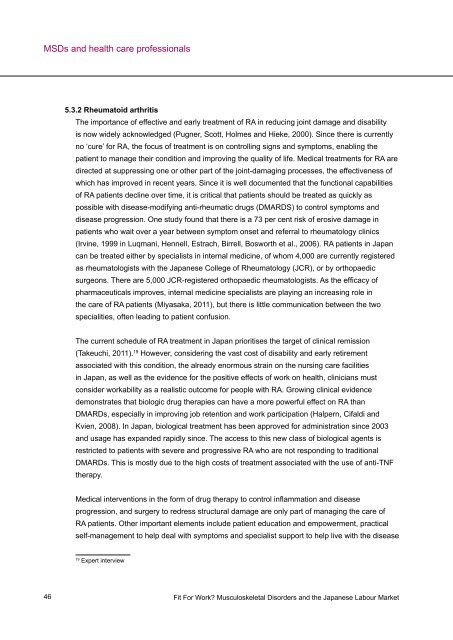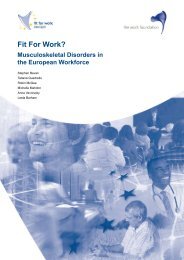English version - Fit for Work Europe
English version - Fit for Work Europe
English version - Fit for Work Europe
Create successful ePaper yourself
Turn your PDF publications into a flip-book with our unique Google optimized e-Paper software.
MSDs and health care professionals<br />
46<br />
5.3.2 Rheumatoid arthritis<br />
The importance of effective and early treatment of RA in reducing joint damage and disability<br />
is now widely acknowledged (Pugner, Scott, Holmes and Hieke, 2000). Since there is currently<br />
no ‘cure’ <strong>for</strong> RA, the focus of treatment is on controlling signs and symptoms, enabling the<br />
patient to manage their condition and improving the quality of life. Medical treatments <strong>for</strong> RA are<br />
directed at suppressing one or other part of the joint-damaging processes, the effectiveness of<br />
which has improved in recent years. Since it is well documented that the functional capabilities<br />
of RA patients decline over time, it is critical that patients should be treated as quickly as<br />
possible with disease-modifying anti-rheumatic drugs (DMARDS) to control symptoms and<br />
disease progression. One study found that there is a 73 per cent risk of erosive damage in<br />
patients who wait over a year between symptom onset and referral to rheumatology clinics<br />
(Irvine, 1999 in Luqmani, Hennell, Estrach, Birrell, Bosworth et al., 2006). RA patients in Japan<br />
can be treated either by specialists in internal medicine, of whom 4,000 are currently registered<br />
as rheumatologists with the Japanese College of Rheumatology (JCR), or by orthopaedic<br />
surgeons. There are 5,000 JCR-registered orthopaedic rheumatologists. As the efficacy of<br />
pharmaceuticals improves, internal medicine specialists are playing an increasing role in<br />
the care of RA patients (Miyasaka, 2011), but there is little communication between the two<br />
specialities, often leading to patient confusion.<br />
The current schedule of RA treatment in Japan prioritises the target of clinical remission<br />
(Takeuchi, 2011). 19 However, considering the vast cost of disability and early retirement<br />
associated with this condition, the already enormous strain on the nursing care facilities<br />
in Japan, as well as the evidence <strong>for</strong> the positive effects of work on health, clinicians must<br />
consider workability as a realistic outcome <strong>for</strong> people with RA. Growing clinical evidence<br />
demonstrates that biologic drug therapies can have a more powerful effect on RA than<br />
DMARDs, especially in improving job retention and work participation (Halpern, Cifaldi and<br />
Kvien, 2008). In Japan, biological treatment has been approved <strong>for</strong> administration since 2003<br />
and usage has expanded rapidly since. The access to this new class of biological agents is<br />
restricted to patients with severe and progressive RA who are not responding to traditional<br />
DMARDs. This is mostly due to the high costs of treatment associated with the use of anti-TNF<br />
therapy.<br />
Medical interventions in the <strong>for</strong>m of drug therapy to control inflammation and disease<br />
progression, and surgery to redress structural damage are only part of managing the care of<br />
RA patients. Other important elements include patient education and empowerment, practical<br />
self-management to help deal with symptoms and specialist support to help live with the disease<br />
19 Expert interview<br />
<strong>Fit</strong> For <strong>Work</strong>? Musculoskeletal Disorders and the Japanese Labour Market







